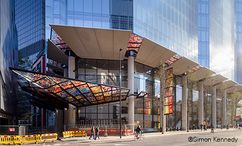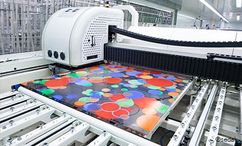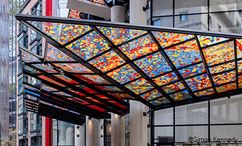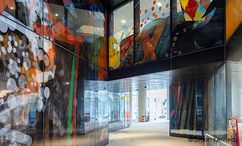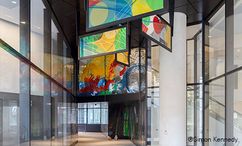In the heart of London "22 Bishopsgate" soars 278 meters into the sky. But one of the most characteristic design features of the building is directly above the heads of passers-by: the glass canopies. They consist of 149 laminates in total, colorfully designed by the artist Alexander Beleschenko. In order to print his designs accurately onto glass, a precise printing technique was necessary, and at the same time the glass itself needed to fulfill high technical demands. The artist, who lives in England but has Russian roots, found this technical competence in Germany, where sedak (Gersthofen) produces safety glass that met the requirements, both in terms of accurate printing and quality.
A strong, colorful counterpoint to the cool metropolitan steel and glass architecture: when you walk along underneath the protruding glass roofs of the new London landmark "22 Bishopsgate" you find yourself immersed in a joyful interaction of color and light. The canopies are filled with blue, yellow, orange, red and green geometric shapes, sometimes opaque, sometimes translucent. Equally color-intensive patterns, like huge brushstrokes on the glass surfaces, can be found on the glass façade and colorfully designed glass elements decorate some of the ceilings in the entrances, serving as friendly indications of where to go. The lively design is strengthened by the many different formats of the glass. They vary in size and form: quadratic, trapezoid, triangular, free-form. No two glass elements are the same, each is unique, a highly imaginative work of art.
The glass was designed by the internationally renowned artist Alexander Beleschenko, who has been using this material to set identity-creating architectural accents for many years. For 22 Bishopsgate he was inspired by the traditional coats of arms of the trade guilds, which were omnipresent in (old) London. He reinterpreted them in a new, abstract way, thereby connecting modern with historic – a phenomenon that is part of everyday life in the British metropolis.
The symbiosis of transparency and color
Using glass for roofs already demands high technical standards (e.g. because of the danger of breakage). What makes the glass elements exceptional in this case is the permanently color-fast and highly precise printing, realized with a ceramic digital process at a resolution of 1080 dpi. This level of exactness goes way beyond the usual standard – on printed paper such as you may be holding in your hands right now, 300 dpi is the norm. If you are reading this online, you are probably looking at a screen with 140 dpi resolution (approximately 4K picture quality). Because ceramic colors are especially stable in terms of tone and do not become bleached even under UV radiation, they are ideal for use outdoors. Beleschenko was impressed with the color stability and especially the extremely high precision: he wanted his space-defining art to have an impact on viewers from a distance as well as up close. This technique enabled him to realize this aim perfectly.
The production went really easily for Beleschenko: he sent his (enormous) files directly to the glass processing company sedak. The pane construction: double-layer safety glass made from 8 mm low-iron glass (heat-strengthened glass) with digital printing. Artwork in position 2 or 3. As the art extends to the façade, there are also printed insulated glass panes. These are each made from two double laminates (6 mm heat-strengthened glass). They are filled with argon and printed in position 2 or 7. In total, sedak supplied 149 laminates and 370 insulated glass panes.
Art and works
Alexander Beleschenko knows how to design and realize large-scale art in architecture. Nevertheless, it is still a special moment for him when he sees his art installed for the first time – at this scale there is no possibility to check the complete work before it is finished. This makes the close cooperation between the artist and the glass processor especially important. With artistic vision, a feel for "the big picture" and know-how in working with the material glass and the possible processing technologies, unique works can be created. If everything is realized perfectly, "in a certain way you see the art rather than the technique", said Beleschenko – the impressive result can now be seen in London at 22 Bishopsgate.


